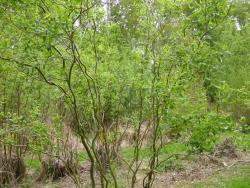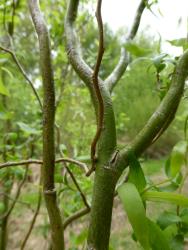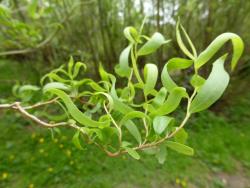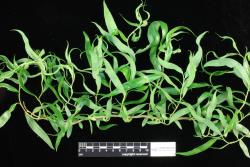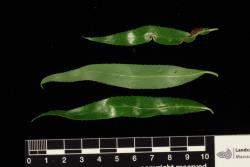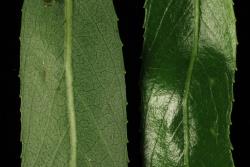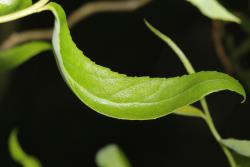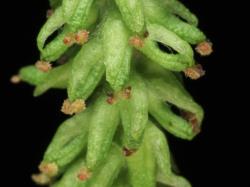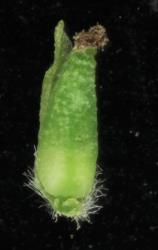Trees to 14 m tall; trunk up to 1.2 m diameter with grey fissured bark, erect with pendulous branchlets, unbranched terminal branchlets up to 1 m long. Current year's branchlets with dense short-silky hairs, 1.9–2.9 mm diameter, sinuous. Year-old branchlets olive-brown (UCL95), glabrous, sinuous. Bud scales ca. 5.0 mm long, 2.5 mm wide, 1.8 mm deep, lanceolate, with 2 angles on the sides, glabrous. Stipule persistent, 8 mm long, very narrowly asymmetrically ovate. Petiole 7–18 mm long, sparsely tomentose, adaxial groove absent, glands absent, yellow or yellow-green. Emerging leaves green, or tinted with orange, with moderately dense to dense long-silky and short-silky hairs. Proximal leaves toothed. Leaf lamina 129–167 mm long, 21–28 mm wide, length to width ratio 4.8–7:1, narrowly ovate-rectangular, not falcate but boat-shaped; base cuneate to rounded; apex narrowly to very narrowly ovate; leaf galls absent; orange rust absent in late summer; margins densely serrulate, flat; upper lamina surface smooth, medium glossy, glabrous, stomata moderately dense to dense; lower lamina surface midvein raised, slightly glaucous, glabrous. Catkins female, rarely male, emergence coetaneous with leaves. Female flowering branch 16–24 mm long with 0–3 leaves. Male flowering branch 22–40 mm long, with 0–5 leaves and sometimes 1 cataphyll. Male catkin 18–30 mm long, 6–8 mm diameter; catkin rachis not visible between flowers. Male flower bract 1.8–2.2 mm long, 0.7–1.0 mm wide, pale green or pale yellow-green, slightly concave; apex round; short-silky hairs on both surfaces and margins. Male nectaries 2, 0.4 mm long, 0.3–0.5 mm wide, yellow. Stamens 2, filaments free or united at the base, hairs present at base of filament; anthers 0.7–0.9 mm long, yellow. Female catkin 14–18 mm long, 4.5–6.0 mm diameter; catkin rachis not visible between flowers. Female flower bract 2.5–3.8 mm long, 0.7–1.0 mm wide, pale green, pale yellow-green or green, channelled, curved inwards on long axis; apex acute, entire or bitten; moderately densely hairy in lower half and with sparse hairs on all margins to apex; female bracts persistent. Female nectary 1, 0.4–0.5 mm long, 0.38 mm wide, yellow; ovary 1.8–1.9 mm long, glabrous, stomata present, shorter than flower bract, sessile; style arms dividing at top of ovary, slightly 2-lobed, hyaline, yellow-green.
The cultivar is easily recognised by its weeping branchlets, twisted leaves and sinuous branchlets. In winter, Salix matsudana 'Tortuosa' is recognisable by the sinuous branchlets. Leaf galls are absent. Most trees are female. Female catkins are short (12–18 mm long), and the flower bract 2.2–3.8 mm long. The ovary is sessile and the basal portion of the style is very short.
Most similar to the 2 forms of Salix ×pendulina, which are also both weeping, but neither of these has twisting leaves and sinuous branchlets. Salix ×pendulina branchlets hang in the same way as those of S. matsudana 'Tortuosa' but are straight.
Sykes (1988, p. 1171) regarded this cultivar as the only form of Salix matsudana present in New Zealand; however, S. matsudana is present in cultivation in New Zealand as a non-tortured, non-weeping form.
Auckland (Tamaki Makaurau 1999, Waihi 1984, Hamilton 1990), Gisborne (Ōpotiki 1977), Volcanic Plateau (Rotorua 1984), Taranaki (Wanganui 2006, Turakina 2000), Canterbury (Kainga 1964, Christchurch 1975, 1980, 1987, 1994, Lincoln 2018), Westland (Westport 1977), Otago (Clyde), Southland (Lake Te Anau 1977).
First collection: CHR 143982, A. J. Healy 64/128, 13 August 1964, Canterbury, Kainga, in swamp: edge of rubbish dump, "No evidence of having been intentionally planted." This tree was unusual in being male.
First publication: Sykes (1982).
Flowering: Mid-September–mid-October.
Unknown.



